Dr. McCleery's Lobo Wolf Park along Route 6 near Kane, Pennsylvania
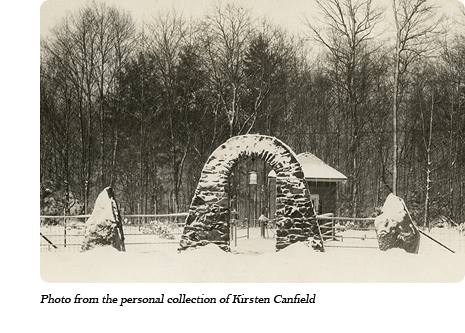 In 1929, Dr. E. H. McCleery (then 62 years old) moved his wolf park to a new location along Route 6 (the Roosevelt Highway) about halfway between Kane and Mt. Jewett, Pennsylvania. He had previously been keeping his "last of the lobo wolves" (the last remaining specimens of the otherwise extinct wolves from the Rocky Mountains and Great Plains) at his home property in the town of Kane, but needed to relocate to a more heavily-traveled area to boost tourism to finance the wolf park.197
In 1929, Dr. E. H. McCleery (then 62 years old) moved his wolf park to a new location along Route 6 (the Roosevelt Highway) about halfway between Kane and Mt. Jewett, Pennsylvania. He had previously been keeping his "last of the lobo wolves" (the last remaining specimens of the otherwise extinct wolves from the Rocky Mountains and Great Plains) at his home property in the town of Kane, but needed to relocate to a more heavily-traveled area to boost tourism to finance the wolf park.197
At first, Dr. McCleery had trouble securing land for a new park, finding that land along the main roads was either not for sale or exorbitantly priced.198 Though several large cities (including Pittsburgh PA, Akron OH, Buffalo NY, and Asheville NC) had expressed interest in hosting the wolves and offered Dr. McCleery assistance if he moved them there,195,198 he wanted to keep the wolves near Kane. After months of frustration, Dr. McCleery was able to purchase 25 acres of land from the Kane Estate in early November 1928.197 The land was heavily-wooded which provided the wolves with the shade they needed.197
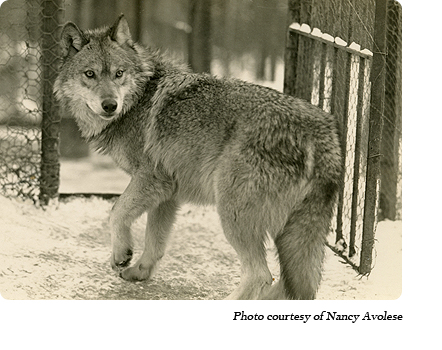 By May 10, 1929 all of Dr. McCleery's 72 wolves (except for the pups still being tamed) had been moved to the new location.200 By that time, a stone archway had been constructed at the entrance to the park. Visitors would drive from Route 6 onto a crushed stone driveway and into the parking area. From there, they would enter the outer gate and follow a path until reaching a small slope lined with rough stone steps. The steps led to the wolf pens, which were surrounded by a crushed wood path along which the visitors would walk to view the wolves.200
By May 10, 1929 all of Dr. McCleery's 72 wolves (except for the pups still being tamed) had been moved to the new location.200 By that time, a stone archway had been constructed at the entrance to the park. Visitors would drive from Route 6 onto a crushed stone driveway and into the parking area. From there, they would enter the outer gate and follow a path until reaching a small slope lined with rough stone steps. The steps led to the wolf pens, which were surrounded by a crushed wood path along which the visitors would walk to view the wolves.200
The wolf pens themselves covered about an acre of ground altogether and were constructed of double-strength wire mesh held up by 11-foot-high200 T-shaped metal poles which allowed wire to be placed over the tops of the pens, preventing the wolves from climbing or jumping out. Enclosed runways were constructed to allow for the transfer of wolves between pens. Each pen was about about 60 square feet236 and contained a "den" constructed of an iron box and stone slaps. During the birthing season, the floor of the box was lined with wooden plans250 to protect newborn pups from the cold metal.
As time went on, more land and more pens were added to the park.1 Electric lights were installed for the benefit of nighttime visitors, and rails were constructed around the pens to keep visitors a safe distance from the wolves (primarily for the wolves' safety). A ticket booth was later added as well.14
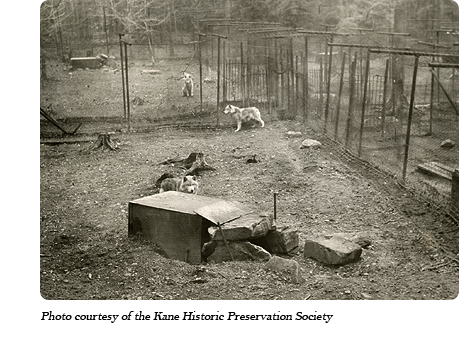 Dr. McCleery's first secretary Myrtle Jarensky owned and operated a tea room at the wolf park2 which was damaged by a fire in 1933.48 It reopened after the fire, and when Rose Carroll became Dr. McCleery's next secretary, she took up the tea room's operation.3 Postcards of the wolves were sold at the park and at various stores in Kane.4
Dr. McCleery's first secretary Myrtle Jarensky owned and operated a tea room at the wolf park2 which was damaged by a fire in 1933.48 It reopened after the fire, and when Rose Carroll became Dr. McCleery's next secretary, she took up the tea room's operation.3 Postcards of the wolves were sold at the park and at various stores in Kane.4
Several signs were erected in the area to advertise the park. In 1932 through at least 1940, admission was 25 cents for adults and 15 cents for children.249,273 By 1950 admission had risen to 30 cents,236 and by 1966 admission was 75 cents for adults235 and 35 cents for children.13 Dr. McCleery greatly enjoyed showing his wolves and describing them to the public.236 He distributed a leaflet to visitors titled "The Only Lobo Wolves In The World,"14 which described the history of the wolves, information about the park, and descriptions of the inhabitants of each of the wolf pens.
Hoping to expand his wolf parks into a franchise, Dr. McCleery created McCleery Wolf Pack Incorporated and set up a new park between Gap and Coatesville, PA in 1930 for the purpose of exhibiting some of his wolves.195 This venture did not last long, however, and no additional wolf parks were established.
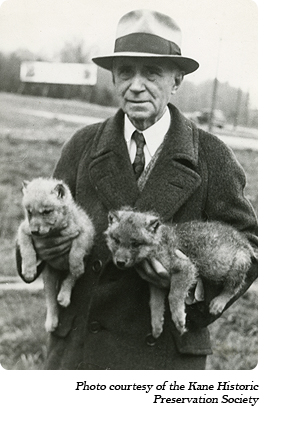 Dr. McCleery added other animals to the park as oppportunity arose. He acquired two owls in 1931, one of which was a snowy owl.79,84 He also kept at least five mountain lions (at least two of which were obtained in the 1940s from Northeastern Utah through Stanley P. Young267) and some coyotes,167 as well as other animals throughout the years. The wolf park became a major tourism attraction in the area and was promoted in travel pamphlets of the Roosevelt Highway, Pennsylvania, and Kane. It gained national notoriety and attracted as many as 2,000 visitors per day during the busiest times of year.236 Several famous people came to visit the wolves, including Stanley P. Young of the U.S. Fish and Wildlife Service (who visited in 1940267), Barnum and Bailey, and Sergeant York.44
Dr. McCleery added other animals to the park as oppportunity arose. He acquired two owls in 1931, one of which was a snowy owl.79,84 He also kept at least five mountain lions (at least two of which were obtained in the 1940s from Northeastern Utah through Stanley P. Young267) and some coyotes,167 as well as other animals throughout the years. The wolf park became a major tourism attraction in the area and was promoted in travel pamphlets of the Roosevelt Highway, Pennsylvania, and Kane. It gained national notoriety and attracted as many as 2,000 visitors per day during the busiest times of year.236 Several famous people came to visit the wolves, including Stanley P. Young of the U.S. Fish and Wildlife Service (who visited in 1940267), Barnum and Bailey, and Sergeant York.44
Dr. McCleery was an active part of the park well into his 80s. As he entered his 90s, he was not able to visit the park as often, and he began to seriously worry about the future of his wolves. Over the years he had received several requests to purchase them but was very particular in his search for a successor; he was searching for someone who would continue in the same spirit as he had done. He was firmly against selling them to zoos because his wolves required constant expert attention which zoos could not provide165 (zoos only began to consider conservation as a central role in the 1970s, and that notion did not become widespread until decades later).
 In 1960 a man named Jack Lynch and his wife Marjorie Lynch visited the wolf park on their Thanksgiving vacation, having read about the wolves in magazine articles. Jack described the visit as "love at first sight" and before heading home, the Lynches expressed interest in purchasing the pack.235 At that time, Dr. McCleery was still considering his options, but he eventually chose the young couple as his successors over the many other interested parties due to their interest and ambition.243 In December of 1961, Dr. McCleery called the Lynches and said "I'm going to die. If you want my wolves, you'd better come."235 The Lynches returned to Kane and purchased the 32 wolves for $1,000 each214 on December 27, 1961.235 The sale was formally announced on February 5, 1962, at which time negotiations for the park land were nearing completion.235
In 1960 a man named Jack Lynch and his wife Marjorie Lynch visited the wolf park on their Thanksgiving vacation, having read about the wolves in magazine articles. Jack described the visit as "love at first sight" and before heading home, the Lynches expressed interest in purchasing the pack.235 At that time, Dr. McCleery was still considering his options, but he eventually chose the young couple as his successors over the many other interested parties due to their interest and ambition.243 In December of 1961, Dr. McCleery called the Lynches and said "I'm going to die. If you want my wolves, you'd better come."235 The Lynches returned to Kane and purchased the 32 wolves for $1,000 each214 on December 27, 1961.235 The sale was formally announced on February 5, 1962, at which time negotiations for the park land were nearing completion.235
The Lynches had plans for the park's improvement, including new walk areas and improvements to the wolf pen fences. They initially planned to keep the park at its location along Route 6, and to retain the McCleery name which had been associated with the park for 40 years.151 Dr. McCleery was pleased with the arrangements made for his wolves, and said, "I am satisfied, my mind is at ease."237 On May 23, 1962, Dr. McCleery passed away. At about the same time, 36 miles away from the hospital, the wolves all started to howl in unison, continuing their song for an unusually long period of time.235,217
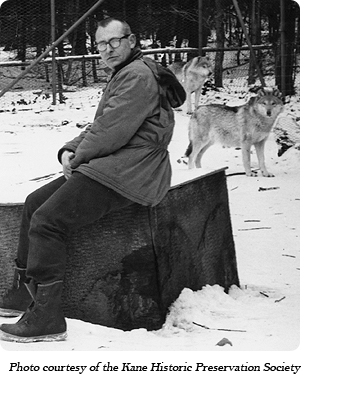 Jack and Marjorie Lynch continued to maintain the wolves at the park. Jack worked directly with the wolves, provided their veterinary care, and presented dramatic tours of the park to the public. Marjorie sold the tickets and collected anecdotes for a book she planned to write titled "Love Me, Love My Lobos." They lived in a three-bedroom trailer on the park property, which they shared with their male malamute named Kim and their female mountain lion named Amigo235 (which, I presume, had been one of Dr. McCleery's mountain lions167). Eventually they began to hand-raise the wolf pups inside their trailer as well.235
Jack and Marjorie Lynch continued to maintain the wolves at the park. Jack worked directly with the wolves, provided their veterinary care, and presented dramatic tours of the park to the public. Marjorie sold the tickets and collected anecdotes for a book she planned to write titled "Love Me, Love My Lobos." They lived in a three-bedroom trailer on the park property, which they shared with their male malamute named Kim and their female mountain lion named Amigo235 (which, I presume, had been one of Dr. McCleery's mountain lions167). Eventually they began to hand-raise the wolf pups inside their trailer as well.235
Jack talked about wanting to move the wolves as early as 1966.235 As time went on, meat became harder to obtain244 and highway changes raised fears of diminishing tourism.248 Jack thought more seriously about moving the pack. In 1970 he bought a 34-acre plot of land on the Olympic Peninsula in Washington with the inheritance left to him by his adoptive mother.217 Marjorie moved there first,248 and in February 1972, after the wolves had been in Kane for 51 years, Jack moved the 52 wolves and one mountain lion246 to a new location across the country in Gardiner, Washington.
Initially Jack retained ownership of the Route 6 park land which led locals to hope that the wolves might return someday.244 However, the land was sold a year later, diminishing hopes of the wolves' return.245 The wolves never did return to Kane, but the remnants of the park - the stone archway and some of the old pens - still remain at the Route 6 location today.
Footnotes
1The article which describes the park's purchase in 1928 describes the plot as 25 acres, but when it was sold it was described as upwards of 100 acres, so more land was added at some point. Originally it was said that the wolves' pens took up about one acre of land, but since the pamphlets range from describing 5 to 13 pens, I imagine more pens were added as time went on, and if more land was acquired, it makes sense to expand the wolf enclosure area. Enclosures would also have had to have been made for the other animals added to the park - the mountain lions, coyotes, etc.
2According to the 1930 census, Myrtle Jarensky was the proprietor of the wolf park's tea room.
3Information courtesy of Carol Mong Gerbracht, who remembers that Rose ran the tea room at the wolf park when Carol's mother manned the ticket booth. Carol remembers an old Victrola in the tea room and chickens in the yard. She and her family moved from Kane in 1953, so she guesses that the tea room was open (but not necessarily in operation - she was too young to remember) at least in the early 1950s.
4Information courtesy of Ron Stafford.
Learn More
Find out more about the Route 6 park by exploring the Locations - Route 6 tag in the archive.
See photos of the Route 6 wolf park here: Page 1, Page 2, Page 3
